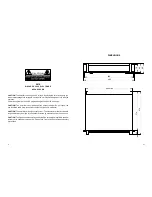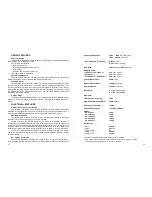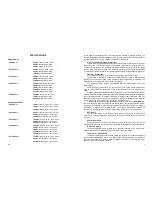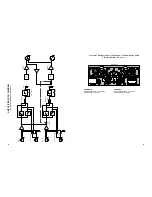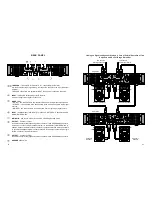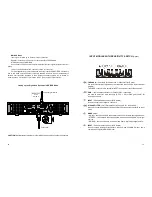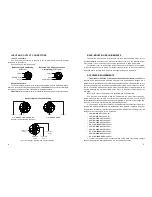
17
16
INPUT AND OUTPUT CONNECTORS
Input Connectors
Use XLR (male) connectors to connect to the amplifier inputs and XLR (female)
connectors to line outputs.
See the wiring on the figures below.
Output Connectors
To connect speaker systems to the outputs of the amplifier, use the SPEAKON NL2FC
or NL4FC connectors in the channel modes. Use SPEAKON NL4FC connectors for bridged
connection or connection of two channels with a single connector
CAUTION!
Never attempt to jumper or otherwise link up any pins of output connectors.
2
1
3
Balanced Input Cable Wiring
(XLR male)
Shield (Ground)
Cold (
–
)
Hot (+)
Balanced Line Ouput Connection
Cable Wiring
(XLR female)
2
1
3
Shield (Ground)
Cold (
–
)
Hot (+)
a) for STEREO and MONO MODE
(Channel 1 and Channel 2 Connectors)
b) for BRIDGE MODE
out (+) out (
–
)
out (
–
) out (+)
Speaker System Connector Wiring
Channel 2
out (+)
Channel 1
out (+)
Channel 1
out (
–
)
Channel 2
out (
–
)
c) for connecting two channels with a single connector
RACK-MOUNTING REQUIREMENTS
The amplifier is designed to fit a standard 19
”
rack. While mounting, make sure to
provide unhindered air access to the front and rear sides of the rack. Fan direction is from
front to back. It is not necessary to leave empty space above or below the amplifier.
For stationary use, it will be enough to fix securely only the front panel of the amplifier
to the rack. However, never attempt to transport the unit unless its rear end is properly
supported and/or securely fixed, as it may be fraught with danger of damage.
AC POWER REQUIREMENTS
1. The
V4-900
MkIII
,
V4-1200
MkIII
,
V4-1800
MkIII
,
V4-2400
MkIII
,
V2-2400
MkIII
amplifiers are
supplied with a three-conductor grounded AC power cord, and should be plugged into a
standard 3-wire grounded electrical outlet which supplies 230V AC 50/60 Hz. Make sure to
connect the amplifier only to sufficiently powerful power supply mains (closer to a switch-
board). If connected to weak power supply mains, the output power of the amplifier may be
reduced producing the so-called
«feeble bass» effect, or the power supply line may be
damaged.
Never try to connect the amplifier to a household power supply mains.
Use the power cord supplied to plug the amplifier into the mains. Prior to plugging,
please, make sure that there are no other devices consuming much AC current, as the
normal operation of such several devices may be impossible. In the event of line voltage sag,
the unit will continue to operate normally, albeit with less power.
2. The actual AC current consumption by the amplifier depends on the type of the music
program and the load impedance. While installing the audio systems, to optimize the power
wiring, please, note that for reproduction of typical audio material at the full output level, the
average current consumption rate is as follows:
–
3 A for
V4-900
MkIII into 8 Ohm;
–
6 A for
V4-900
MkIII into 4 Ohm;
–
4 A for
V4-1200
MkIII into 8 Ohm;
–
8 A for
V4-1200
MkIII into 4Ohm;
–
5 A for
V4-1800
MkIII into 8 Ohm;
–
1
0 A for
V4-1800
MkIII into 4 Ohm;
–
4 A for
V2-2400
MkIII into 8 Ohm;
–
8 A for
V2-2400
MkIII into 4 Ohm;
–
1
6 A for
V2-2400
MkIII into 2 Ohm;
–
8 A for
V4-2400
MkIII into 8 Ohm;
–
1
6 A for
V4-2400
MkIII into 4Ohm.
3. In order to minimize the AC current hum and noise, make sure to plug all audio
devices interconnected with signal cables, into the same mains outlet.

